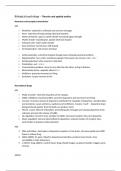Biological psychology – Theories and applied studies
Neurones and synaptic transmission
A01
o Dendrites- attached to cell body and receives messages
o Axon- extension of body passing electrical impulses
o Nodes of Ranvier- gaps in myelin sheath increasing signal strength
o Myelin sheath- insulating fat, speeds electrical impulse
o Schwann cells- make myelin sheath
o Axon terminal- end of axon, bell shaped
o Terminal button- end of axon terminal
o Action potential- a electrical impulse though axons releasing neurotransmitters
o Depolarisation- Na+ enters membrane quicker than pump can remove, out= - in=+
o Resting potential- when neurone is dormant
o Polarisation- out = + in = -
o Concentration gradient- more on one side than the other, trying to balance
o Electrostatic forces- opposite attract (+/-)
o Inhibitory- prevents neurones for firing
o Excitatory- causes neurone to fire
Recreational drugs
A01
o Mode of action- what the drug does at the synapse
o GABA- inhibitory neurotransmitter, prevents dopamine and neurones from firing
o Cocaine- increases release of dopamine and blocks the reuptake of dopamine, noradrenaline
and serotonin, causes alertness, euphoria and confidence. Cocaine ‘crash’ – dopamine stops
being produced quicker than the body can produce more
o Heroin- causes influx of endorphins, preventing pain messages and causing dopamine to be
released, prevents the release of GABA
o Up regulation- become more sensitive to GABA, increased receptor sites, less dopamine
o Down regulation- become desensitised to dopamine, reduced number of receptor sites,
work harder to produce action potential
A03
Olds and Milner- electrodes in dopamine receptors of rats brain, rats press pedal over 2000
times to release drug
Noble (2000)- A1 gene, linked to dopamine production, produce lower levels, more
susceptible to risky behaviours
Li (2013)- drug addicts/ control shown drug related images e.g spoon/needles, triggers parts
of brain
A03CA
, Alexander (1998)- luxury rat park- rats in dull rat park were less likely to self-administer
drugs- shows situational influence
Siegel- context dependent overdosing- experimented on rats -shows situational influence
Brain structure and aggression
A01
o Frontal lobe- regulating behaviour, semantic memory
o Parietal lobe- body sensations, sensory memory, language
o Occipital lobe- vision, eyes=>optic nerve=>occipital lobe
o Temporal lobe- contains limbic system
o Periaqueductal grey matter- links amygdala and prefrontal
cortex, damage can cause defensive aggression
o Offensive-attack(medial- middle)
Defensive-territorial/protecting(dorsal-back) Predatory-
food(lateral-side)
A03
Case study of Phineas Gage: Damage to prefrontal cortex- caused major personality change-
considerate and friendly to aggressive and impulsive- shows influence of prefrontal cortex,
amygdala, on aggressive tendencies – controls self-control and decisions
Kluver-Bucy syndrome- lesioned temporal lobe of monkey with fear of snakes and birds- no
longer displayed fear – explains aggression as person wouldn’t have fear if damaged
temporal lobe , no fear of consequences so acts aggressively. Removal of amygdala lead to
tameness and placidity
Urbach-wiethe syndrome- damage to amygdala, becomes withered. Pps with/without
shown horrifying film- damaged amygdala participants are more likely to only recall
mundane scenes- more aggressive so don’t have fear of consequences.
Charles Whitman- serial killer – killed random strangers, possible explanation due to tumour
against amygdala
Raine classic study supports influence of brain structure on aggression- lower levels of
activity in murderers pleading NGRI in the prefrontal cortex, corpus callosum and limbic
system
A03CA
Biological explanations can be reductionist and determinist => ignores social and learning
factors, implies violent individuals have little control of actions due to biological makeup-
may give offenders excuse for actions
Brain scans are not always valid- (don’t isolate exact point, ‘background noise’)
No cause and effect is established as cannot know if brain structure differed due to the
aggression or the aggression was due to the brain structure




